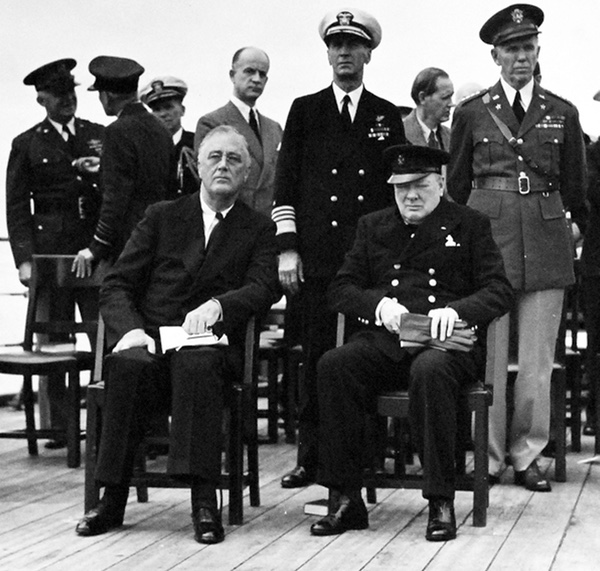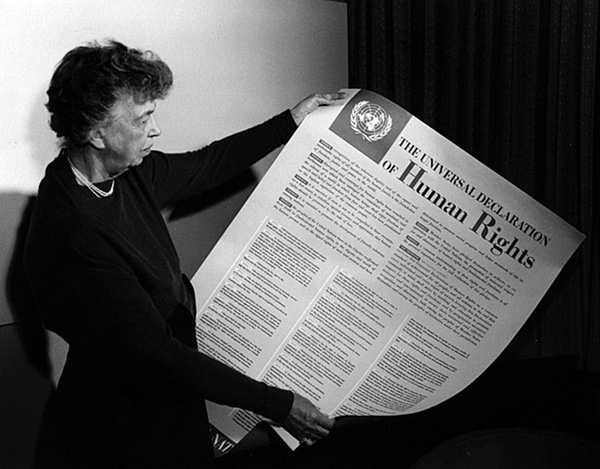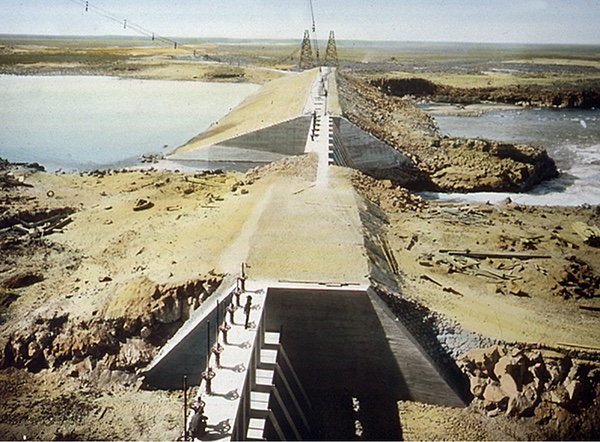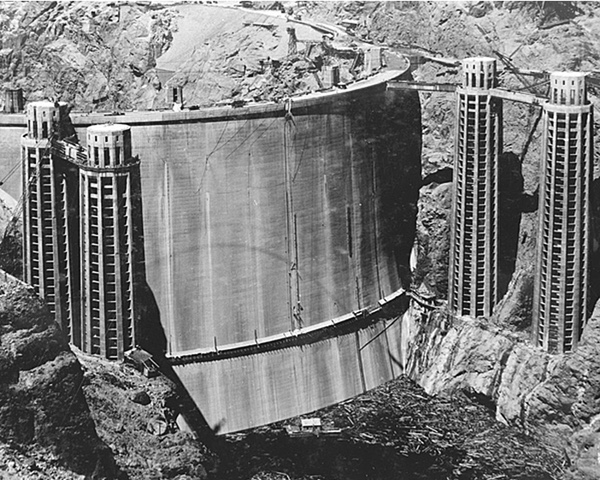America’s moral obligation to develop astroelectricity
by Mike Snead
Monday, February 14, 2022
Over the last two centuries, non-renewable energy-powered industrialism has created a prosperous American middle class. While not extravagantly rich, these Americans live comfortably through earnings from their talents and labors. This path to middle class prosperity through industrialization has been widely embraced worldwide and is now considered to be an inalienable human right.
| To supply the abundant green energy needed to globally achieve freedom from want requires a practicable progressive green energy engineering solution—an engineering solution that makes all our lives better. |
In his January 1941 State of the Union address, eleven months before war came to America, US President Franklin Roosevelt defined middle-class prosperity as having achieved “freedom from want”. With this pronouncement, he started a series of political dominos that made achieving freedom from want a rightful aspiration for all peoples everywhere. As a consequence, all moral governments have an obligation to enable freedom from want to become a reality when technological progress so enables.
Industrial freedom from want requires abundant supplies of energy. For all free peoples of the world to achieve and remain free of want, they must also have abundant supplies of middle-class affordable energy. However, the past century has demonstrated that this aspiration cannot be globally achieved using predominantly non-sustainable fossil carbon fuels. In fact, the natural inequity for access to these fuels has created substantial strife and suffering due to political and economic competition for these scarce resources. Wars have been fought and millions have died as nations sought to ensure their oil energy security or deny it to others. A peaceful future for humanity requires that abundant supplies of middle-class affordable and sustainable energy be available globally.
The world is now beginning to accept that a global transition to true sustainable (green) energy must be undertaken this century. To supply the abundant green energy needed to globally achieve freedom from want requires a practicable progressive green energy engineering solution—an engineering solution that makes all our lives better. Astroelectricity generated from space solar power can, this century, become the predominant source of this needed green energy. This article explains why America, having embraced Roosevelt’s aspiration of freedom from want as an inalienable moral aspiration for everyone everywhere, now has a moral obligation to lead the free peoples of the world in making abundant astroelectricity a global reality to ensure a peaceful and prosperous future for all.
Roosevelt’s 1941 Four Freedoms speech
The summer and fall of 1940 was a tumultuous time for much of the world. European nations, except for Great Britain, had fallen to tyrannical political and military conquest while the same was happening in much of the Western Pacific. A key world history-pivoting air battle—the Battle of Britain—was underway as Britain fervently fought to deny its enemy the air dominance necessary for invasion. Fortunately, Britain succeeded!
As had happened prior to America’s 1917 entry into The Great War—as World War I was then called—in 1940, America was again formally neutral to the brutal conflict then underway in Europe. However, American commercial contracts to supply Britain with needed war materiel and key civilian supplies, such as food and oil, significantly boosted America’s economy at a time when many Americans still struggled to emerge from the then decade-long Great Depression. Also, morally troubling war news from Europe and the Pacific had begun to erode the public’s desires for remaining neutral in the face of the tyrants’ growing battlefield successes. Eventually, as most Americans expected, the war came to America in late 1941.
Franklin Roosevelt was first elected president in 1932, primarily on a socialist economic platform to create a substantial government helping hand—known as the “New Deal.” Yet, by the late 1930s, those economic reforms had generally not succeeded in correcting America’s faltering economy. Socialism does not create the consumer demand for progress—new products and services—that brings real sustained economic growth and middle-class prosperity. Further, during a decade when belligerent totalitarian governments were arming for conquest, America’s military preparedness generally waned due to the economic priorities of the president and Congress. Despite these unsettling circumstances, Roosevelt won reelection for a third term in 1940 with 55% of the total vote.
Following his 1940 election victory, Roosevelt had two important speeches coming up in January 1941. The first was his annual State of the Union (SOTU) address to Congress while the other was his third inauguration speech just three weeks later. In preparing for the SOTU address, Roosevelt understood that he could not ignore the growing threat of war coming to America. In this speech, Roosevelt made it clear that America was moving from a peacetime economy to a wartime economy.
During the Great War, Roosevelt was the Assistant Secretary of the Navy. America had reluctantly entered that war primarily to help end the battlefield stalemate stretching across Europe that was costing a tremendous loss of life. Total combat and civilian deaths in that war are estimated at around 20 million. (More than 50,000 Americans were killed in combat in only a year’s time. This was more than the combat deaths in the 11 years of the Vietnam War and nearly eight times as many American combat deaths in the more than two decades since September 11, 2001. Most who fought in World War I were only in their 40s in 1940 as war again ravaged the world.)
While Roosevelt had championed expanding the Navy in 1914 when the war in Europe started, he subsequently became a pacifist after visiting the frontline in France in 1918 as Americans were fighting. In 1934, after being elected president, he explained why he had become a pacifist.
“I have seen war. I have seen war on land and sea. I have seen blood running from the wounded. I have seen men coughing out their gassed lungs. I have seen the dead in the mud. I have seen cities destroyed. I have seen two hundred limping, exhausted men come out of line—the survivors of a regiment of one thousand that went forward forty-eight hours before. I have seen children starving. I have seen the agony of mothers and wives. I hate war.”
As the threat of war grew in 1940, Roosevelt understood his obligation as president and commander in chief to lead the nation in fighting an unwanted war despite his personal hatred of war. While the State of the Union speech was being written, Roosevelt dictated his explanation of why America would go to war, should it become necessary. He saw it not only as the need to defend America’s liberty, but as an opportunity to end the human suffering that often creates wars or results from wars. Politically, his globalist view would move America to begin to become a shaper of moral world politics and acceptable national behavior. Roosevelt especially wanted to make clear that tyranny was repugnant and must be defeated.
In the 1941 SOTU address, Roosevelt defined four freedoms that he thought should be universal human rights and become the basis for a new world political order.
In the future days, which we seek to make secure, we look forward to a world founded upon four essential human freedoms.
The first is freedom of speech and expression—everywhere in the world.
The second is freedom of every person to worship God in his own way—everywhere in the world.
The third is freedom from want–which, translated into world terms, means economic understandings which will secure to every nation a healthy peacetime life for its inhabitants—everywhere in the world.
The fourth is freedom from fear–which, translated into world terms, means a world-wide reduction of armaments to such a point and in such a thorough fashion that no nation will be in a position to commit an act of physical aggression against any neighbor—anywhere in the world.
That is no vision of a distant millennium. It is a definite basis for a kind of world attainable in our own time and generation. That kind of world is the very antithesis of the so-called new order of tyranny which the dictators seek to create with the crash of a bomb.
As the war drums threatening America grew louder during 1941, Roosevelt began to establish the political alliances that he knew would be needed to defeat the growing totalitarian threat. Britain had, with American help, managed to hold on against the prolonged air bombardment of its cities and attempts to blockade the island nation into starvation. Roosevelt understood that should war come to America, Britain would become America’s gateway to free Europe of tyranny.
The emergence of the United Nations
Roosevelt had first met Winston Churchill in 1918 while traveling to Europe. Becoming the British prime minister as war broke out in Europe, Churchill immediately tried to enlist America formally as an ally. Finally, in August 1941, this alliance would begin with the Atlantic Charter.
That June, the governments of Great Britain, Canada, Australia, New Zealand, the Union of South Africa, and the exiled governments of Belgium, Czechoslovakia, Greece, Luxembourg, the Netherlands, Norway, Poland, Yugoslavia, and France had formalized a military and political alliance. However, this alliance did not have the industrial capacity, manpower, and oil needed to bring victory. They needed America’s industries, soldiers, and oil. By late summer 1941, battlefield losses were threatening the cohesion of this alliance. The very real potential existed that all of Europe could be lost.
 President Roosevelt (left) and British Prime Minister Churchill (right) meeting in August 1941. |
Traveling by warships, Churchill and Roosevelt met in secret off the coast of Newfoundland, a large island off the coast of North America. The purpose was to reach a formal agreement that would end America’s neutrality in favor of supporting Britain and establish a trajectory to a new world political order once victory was achieved. The agreement, becoming known as the “Atlantic Charter”, included these eight provisions:
- No territorial gains were to be sought by the United States or the United Kingdom.
- Territorial adjustments must be in accord with the wishes of the peoples concerned.
- All people had a right to self-determination.
- Trade barriers were to be lowered.
- There was to be global economic co-operation and advancement of social welfare.
- The participants would work for a world free of want and fear.
- The participants would work for freedom of the seas.
- There was to be disarmament of aggressor nations and a common disarmament after the war.
The Atlantic Charter was the first step in the “cooperation of free countries” Roosevelt mentioned in his State of the Union address. Among the eight provisions were the freedom from want and fear mentioned in his January address.
| Today, without affordable fossil carbon fuels, industrialism cannot readily gain a foothold in impoverished nations. For those living with this energy impoverishment, their right to be able to earn a middle-class standard of living is being impaired. |
During the discussions with Churchill, Roosevelt suggested the name “United Nations” for those countries that would join America and Britain in supporting these provisions. Within just three weeks of the December 7, 1941, attack at Pearl Harbor, the Atlantic Charter would become the political basis for today’s United Nations.
On January 1, 1942, the “Declaration by United Nations” was created by the United States, Great Britain, the Union of Soviet Socialist Republics, and the Nationalist Chinese government (now the government of Taiwan). The next day, 22 more nations joined the declaration. The opening of this declaration clearly states that the parties embraced the eight principles of the Atlantic Charter. Thus, this declaration carried Roosevelt’s inalienable human rights of freedom from want and fear into the original formation of a new world political order.
Having subscribed to a common program of purposes and principles embodied in the Joint Declaration of the President of the United States of America and the Prime Minister of the United Kingdom of Great Britain and Northern Ireland dated August 14, 1941, known as the Atlantic Charter.
As the number of countries joining the declaration grew throughout World War II, a further series of international agreements followed addressing monetary and economic policy, civil aviation, war planning, and post-war recovery. By 1945, this cooperation of free countries had grown to 50 nations.
United Nations Declaration of Human Rights
Throughout 1941, America continued its shift to a war economy. America’s undamaged industrial capacity and then still substantial domestic oil resources were instrumental in achieving, with its allies, a military victory. Having been reelected to a fourth term in 1944, President Roosevelt died on April 12, 1945. The war in Europe ended less than a month later, on May 8, and the war in the Pacific ended on August 15. On November 24, the 50 victorious nations formed the United Nations as the formal basis for the new political “world order” Roosevelt spoke of achieving in 1941.
 Eleanor Roosevelt holds a copy of the Universal Declaration of Human Rights |
President Roosevelt’s wife, Eleanor, was a forceful political presence during her husband’s presidency. Roosevelt’s successor, Harry Truman, appointed her as America’s first envoy to the new United Nations (UN). In this capacity, she chaired the committee to draft the UN Declaration of Human Rights—to give permanence to her husband’s vision of freedom.
In the United States, the fundamental rights defined in the US Constitution’s first ten amendments—commonly called the “Bill of Rights”—provide a key foundation for American law and moral government functioning. Like America’s Bill of Rights, the UN Human Rights Declaration, adopted in 1948, forms a key basis for international law and, consequently, for establishing moral operations of the United Nations and the obligation of its national parties to respect and uphold these declared rights.
In the second paragraph of the preamble to the Human Rights Declaration, freedom from fear and want is defined as a rightful human aspiration everywhere.
Whereas disregard and contempt for human rights have resulted in barbarous acts which have outraged the conscience of mankind, and the advent of a world in which human beings shall enjoy freedom of speech and belief and freedom from fear and want has been proclaimed as the highest aspiration of the common people.
This declaration has 30 articles defining the universal and inalienable rights of all peoples. Article 23 states that everyone has a “right to work”. Article 25 states that everyone has a “right to a standard of living adequate for the health and well-being of himself and of his family.” Essentially, these two rights define what, as a minimum, having freedom from want means—the right to use one’s talents and labors to earn a living “including foods, clothing, housing and medical care and necessary social services, and the right to security in the event of unemployment, sickness, disability, widowhood, old age or other lack of livelihood in circumstances beyond his control.” In industrialized nations, this is called a middle-class standard of living. Essentially, the declaration bestows on everyone the freedom from want right to be able to earn a middle-class standard of living.
Being energy secure is a prerequisite for achieving freedom from want
The Human Rights Declaration defined the fundamental legal, cultural, and economic rights usually associated with a middle-class standard of living. However, it is impossible to achieve (and keep) a modern middle-class standard of living without the affordable energy needed to live comfortably and to purchase affordable goods and services. Essentially, the declaration implicitly states that everyone everywhere has a fundamental right to have access to the affordable energy needed to earn a middle-class standard of living. Consequently, being secure with affordable energy is a government’s moral obligation to accomplish.
Achieving freedom from want is not possible with fossil carbon fuels
Industrialism is the capacity to utilize energy from other than human or animal effort to increase the productivity of our human labors. Essentially, industrial energy enables humans to live above a peasant’s hand-to-mouth standard of living.
The industrial use of fossil carbon fuels began nearly 300 years ago with the use of coal to fuel the first steam engines in Britain. Since that time, coal, oil, and natural gas have enabled industrialism and the opportunity for freedom from want to spread to about 50% of the world’s population. However, this leaves nearly four billion people where freedom from want remains an unachievable aspiration. Today, without affordable fossil carbon fuels, industrialism cannot readily gain a foothold in impoverished nations. For those living with this energy impoverishment, their right to be able to earn a middle-class standard of living is being impaired.
Remaining free of want is not possible with fossil carbon fuels
For those now comfortably a part of the fortunate 50% where a middle-class lifestyle is achievable, the substantial dependence on non-sustainable industrial fossil carbon fuels makes this prosperity fleeting. Absent an orderly transition to abundant green energy, escalating fossil fuel prices, driven by a growing world demand and diminishing supplies, will likely push many of the fortunate 50% back into energy scarcity-driven poverty. This forced return to widescale energy impoverishment is a catastrophe that is inevitable unless prudence succeeds in spurring an orderly transition to practical green energy supplies. Unfortunately, such prudence is not yet evident in the body politic, either in the United States or globally.
The world needs the green power equivalent of 25,000 Hoover Dams
As explained here previously (see “An assessment of EU decarbonization options including astroelectricity”, The Space Review, November 15, 2021), the per person energy consumed within the European Union (EU) provides the annual energy needed to sustain a comfortable middle-class lifestyle. When expressed in terms of the equivalent green electricity, an EU middle-class lifestyle requires a continuous electrical power supply of about five kilowatts (kW) to meet all energy needs. To help visualize the amount of green electricity needed, each person would need the electrical power that could operate five countertop microwave ovens continuously. This is equal to 5 kW × 24 hours per day × 365 days per year = 43,800 kilowatt-hours (kWh) of electrical energy each year. This is the amount of green energy required per person to enable freedom from want to be achieved—in short, to “go green”.
 Comparing Europe and Africa’s nighttime images provides an indication of the relative standard of living. |
Many people in Africa today live with substantial energy impoverishment, as the image above illustrates. By 2050, the population of the continent of Africa is projected to nearly double from around 1.3 billion today to 2.5 billion. Inescapable energy impoverishment will most likely embrace most of these new Africans bringing misery and, likely, conflict.
| Truly enabling everyone everywhere to achieve freedom from want will require effective progressive engineering actions, undertaken on a realistic timeline. |
Many world politicians advocate for 2050 being when the use of fossil carbon fuels should end, presumably, to be replaced by green energy. To accomplish this in Africa by 2050 will require 5 kW × 2.5 billion people = 12,500 million kW, or 12,500 gigawatts (GW) of continuous green electrical power. For perspective, the Hoover Dam can generate 2 GW of electrical power. Hence, achieving sustainable middle-class prosperity for Africans by 2050 would require building a green power generation capacity equivalent to that of 6,250 Hoover Dams.
Some estimate that the world population will near 10 billion by 2050. Achieving freedom from want globally would then require a green power generation capacity of 50,000 GW of continuous green electrical power. For the world to achieve freedom from want through sustainable development, the world will, in 30 years, need to build a green energy generation capacity equal to 25,000 Hoover Dams! Obviously, soaring political rhetoric championing wind and ground solar power will not accomplish this.
Roosevelt defined freedom from want as one of the four conditions needed to remove the root causes of most wars and hardship. Obviously, energy impoverishment is one such root cause. The UN Human Rights Declaration defines freedom from want as a rightful human aspiration, establishing an obligation that moral governments have a responsibility to meet. However, progressive political actions alone, such as the recent UN Climate Change Conference 2021, have accomplished little since they began a generation ago. Truly enabling everyone everywhere to achieve freedom from want will require effective progressive engineering actions, undertaken on a realistic timeline, to build a continuous green electrical power generation capacity equivalent of 25,000 Hoover Dams. The precedent to follow to meet this need was established in the United States in the 1930s with federal programs to build large hydroelectric plants.
The beginning of hydroelectricity in the United States
 The site of the first American hydroelectric dam built on the Fox River at Appleton, Wisconsin in 1882. |
In the United States, green electricity generation started in 1882 when a water-powered Edison direct current (DC) dynamo was installed in Wisconsin. That same year, Edison’s first steam-powered dynamo plant was opened in New York City while a small hydroelectric plant was also built at Niagara Falls.
Edison’s DC dynamo plants had the substantial limitation in that DC electrical power could only be cost-effectively delivered by transmission lines to a customer located within about one mile of the plant. Over longer distances, too much power was lost by wire resistance during the transmission. This made DC dynamos impractical for large hydroelectric plants located away from urban areas.
The electrical genius, Nicola Tesla, solved this problem with the invention of alternating current (AC) generators and AC motors. Alternating current electricity could be efficiently transmitted by wire for much longer distances. In the early 1890s, a hydroelectric plant was built at Niagara Falls to supply Buffalo, New York—26 miles away—with AC electricity.
The importance of AC electricity to the Industrial Revolution was that Tesla’s AC motors enabled the initial mechanical power driving the generators to be recreated at another location with the flip of a switch. The ready availability of reliable transmitted AC electrical power attracted industry to Buffalo. Efficient, affordable green electricity brought middle-class freedom from want to those willing to work in the growing industries in Buffalo. By 1899, seeking to replicate Buffalo’s success, 200 hydroelectric plants were operating in the United States.
How the US government took the lead in macro-hydroelectricity development
In the American West, water for irrigation was needed. Civilizations going back to the ancient Egyptians have been using hydraulic engineering to tap available river water to irrigate farmland.
 Minidoka dam being built. |
The first federal hydroelectric project was completed in 1910 at the Minidoka Dam on the Snake River in Idaho. This earthen dam is 26.2 meters (86 feet) tall and nearly 1.6 kilometers (one mile) long. Undertaken by what became known as the Bureau of Reclamation within the US Department of the Interior, the dam was designed to create a large reservoir to provide irrigation water enabling 4,140 square kilometers (1,600 square miles) of surrounding desert to be converted into productive farmland. This created over 2,000 farms and established six new towns.
As the dam was being built, a 20,000-kW hydroelectricity plant was added to power irrigation pumps. Excess electrical power was sold to local towns to resell to local users once transmission and local distribution lines were built. Electricity prices were set by the federal government. For example, a monthly use of 1,000 kWh—likely by a small business—would have been charged $18.50 or $0.0185 per kWh (about $0.50 per kWh in 2021).
The Colorado River was first investigated as a location for a hydroelectric dam in 1902 by the Edison Electric Company of Los Angeles. In 1922, the Bureau of Reclamation presented a plan for a large dam to be used to supply irrigation water and electricity. While the project title included the name “Boulder Canyon”, the chosen site was Black Canyon, several miles away. Black Canyon had the better geological formations and suitable logistics access from Las Vegas, then a small town.
 Upstream side of the Hoover Dam at the end of dam construction. |
As was customary at the time, government engineers designed the dam project, preparing extensive drawing and specifications that private companies would use to bid the project. From a civil engineering perspective, the dam project was a substantial leap forward in size and complexity. As built, the concrete Hoover Dam stands 221.4 meters (726.4 feet) tall and is about two-fifths of a kilometers (a quarter mile) wide at the top. The dam is used for irrigation, flood control, and potable water supply. Surprisingly, electricity generation was only added late in the project design when it was realized that electricity sales would enable the cost of the dam to be recovered through long-term delivery contracts to meet the West’s growing need for electricity.
| In our industrial culture, abundant and affordable green energy will be essential to globally achieve and maintain freedom from want. If freedom from want is truly a legitimate human aspiration, astroelectricity is now the only practical progressive engineering solution to make this aspiration a reality. |
In 1928, Congress passed the Boulder Canyon Project Act authorizing the Bureau of Reclamation to spend $165 million to build the Hoover Dam. Prior to the final authorization, water and power delivery contracts were negotiated with seven surrounding states. Of the then-year $125 million total estimated construction cost of the Hoover Dam, $25 million was allocated to flood control and was financially handled separately. Of the remaining $100 million, $18 million was for purchase of the electrical generation equipment which would then be leased to the operators to recover those costs. The balance of $83 million was financed by bonds for 50 years with interest in the range of 3–4%. With interest payments, the total 50-year cost would be $191 million. This was covered by $207 million to be raised through 50-year electricity delivery contracts signed prior to the start of construction. These bonds were retired in 1987.
An annual guaranteed minimum delivered electrical energy of 4,330,000,000 kWh was estimated by the government. (For 1947–2008, an average of 4,200,000,000 kWh was generated.) The electricity was sold to California, Nevada, and Arizona at a wholesale price of $0.00163 per kWh—an order of magnitude lower than the Minidoka rate. For perspective, the 2021 inflation adjusted rate would be $0.0106 per kWh.
From 1987 to 2017, the original electricity delivery contracts were extended while new contracts were negotiated. In 2017, Congress approved new 50-year delivery electricity contracts to run through 2067 at a wholesale price of around $0.02 per kWh. Current US wholesale prices of electricity are usually in the range of $0.02–0.06 per kWh. Since there are no fuel costs with hydroelectricity and maintenance costs are minimal, this enables a long-term delivery contract with a fixed cost to be used. Over the 50-year length of this contract, with an assumed capacity factor of 25 percent, the Hoover Dam will produce about $4 billion in revenue for the government.
In undertaking the Hoover Dam, Congress agreed to underwrite the construction cost of an unprecedented macro-engineering project substantially larger and more complex than the Minidoka project. Further, Congress approved the use of 50-year delivery contracts and 50-year government-backed bonds to recover the cost of construction. This became a model for other government-backed hydroelectric projects.
Of course, this Congressionally-approved financing model can now be used to construct the first American astroelectric systems. At $0.02 per kWh, a five-gigawatt astroelectric system would generate about $870 million in revenue each year, or about $40 billion over a 50-year period of a delivery contract. An initial contract to build ten such systems would bring in $400 billion in revenue to help recoup the cost of building the systems. At the current retail cost of Midwest wind power of around $0.05 per kWh, each astroelectric system would generate around $110 billion over 50 years.
Hydroelectricity was used to eradicate rural America’s electricity impoverishment
When Roosevelt became president in 1933, a large portion of the US population did not yet have access to utility-supplied electrical power because they lived on farms and in small farming communities. This created a substantial disparity in the standard of living compared to urban areas. Private electric utilities, primarily using coal-fired power plants, focused on supplying the urban areas where the growing electrification of industries, businesses, street lighting, and homes made private investment very attractive.
Roosevelt used the Hoover Dam project—named after his predecessor, Herbert Hoover, a prominent civil engineer prior to becoming president whose administration had begun the project—to spearhead building hydroelectric facilities across the southern and western United States. Roosevelt wanted to bring to rural America the convenience and substantially improved rural standard of living provided by electrical power. He wanted to do for America what now needs to be done for the world.
In 1935, about 25% of Americans—nearly all of those living in rural America—did not have utility electrical power. Federal-led electrification, such as through the formation of the federal Tennessee Valley Corporation in 1933, brought rural electrification and industrialization generally across the United States. Fortuitously, this then ambitious government effort was soon proven to be vital to powering America’s war economy in the South and West.
Through the nationwide rural electrification program, by 1970 almost all Americans had access to utility-supplied electrical power. Access to electricity gave all Americans the opportunity to live a middle-class lifestyle. This transition took almost 90 years to complete.
Astroelectricity is the world’s hydroelectricity “solution”
In “The Coming Age of Astroelectricity,” space-solar-power-generated astroelectricity is shown to be the only practical means of providing the world with the equivalent of the 25,000 Hoover Dams of green electrical power generation capacity needed to achieve freedom from want. While nuclear, wind, ground solar, hydroelectricity, and other terrestrial renewable energy sources will probably provide about twenty percent or 10,000 GW of the needed 50,000 GW, developing astroelectricity will be essential to globally achieve freedom from want. Increasingly, governments such as Great Britain, Japan, and the European Union are recognizing the necessity of pursuing space solar power.
Surprisingly, having been invented in America in 1968 by Peter Glaser and extensively studied by NASA and the US Department of Energy since the 1970s, undertaking space solar power is not yet an American political priority. The US government, increasingly focused on fervent environmentalism, appears to be blind to the need to undertake astroelectricity to secure America’s and the free world’s future peaceful prosperity powered by abundant green energy.
America’s moral obligation is to lead in developing astroelectricity
By making freedom from want a rightful aspiration for everyone everywhere as part of a new “world order”, President Roosevelt also made it America’s moral obligation to lead the technological advancements that will enable this aspiration to be achieved everywhere. Almost a century later, with nearly a quarter of the world’s population still living without utility electricity and nearly half lacking the energy-enabled opportunity to achieve middle class prosperity, the time has arrived for America to fulfill this obligation. As can be anticipated by Africa’s rapidly growing impoverished population, the world’s overall energy security situation will only get much worse absent an orderly progressive engineering plan to industrialize space solar power. The time for bold American leadership has arrived!
Conclusion
At the end of the four freedoms part of his speech, Roosevelt stated:
The world order which we seek is the cooperation of free countries, working together in a friendly, civilized society… Freedom means the supremacy of human rights everywhere. Our support goes to those who struggle to gain those rights or keep them.
In our industrial culture, abundant and affordable green energy will be essential to globally achieve and maintain freedom from want. If freedom from want is truly a legitimate human aspiration, astroelectricity is now the only practical progressive engineering solution to make this aspiration a reality. American government leadership in developing space solar power-generated astroelectricity is now essential to enable America and the free world to undertake an orderly transition to abundant green energy and avoid future warfare over increasingly unaffordable fossil carbon fuels.
The time has come to bring astroelectricity to the world. President and Mrs. Roosevelt made this America’s moral obligation to achieve! America can no longer afford to ignore this obligation. It’s time to put fervent environmentalism aside and focus on making abundant green energy available to everyone everywhere a shared political priority.
Note: we are using a new commenting system, which may require you to create a new account.
No comments:
Post a Comment